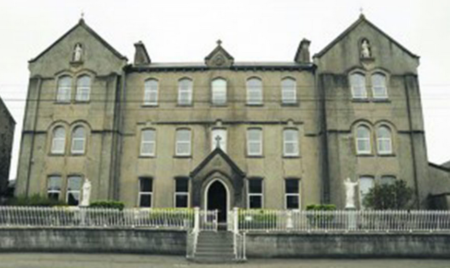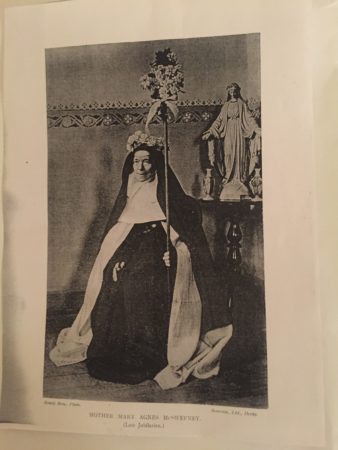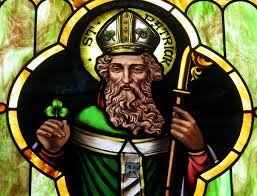When we invoke St. Patrick on his feast day to “bestow a sweet smile on us” his “poor children”, perhaps it would enrich our singing to know a little bit about the Mercy Sister, Sr. Agnes, who composed the well-known hymn: Hail Glorious St. Patrick.
Who was Sr. Agnes? Elizabeth, known as Eliza, McSweeny (Sweeney), daughter of Michael and Ellen McSweeny (nee Galway) was born in Cove/Queenstown in November 1823. She was a half niece of Fr. Thomas Croke, C.C. who baptised her. (Later, Fr.Thomas Croke was appointed P.P. of Charleville and was instrumental in bringing the Sisters to the town in 1836.)
As her father was of some means, a customs officer, Elizabeth was fortunate to receive a good education. In the Bathurst Convent Annual of 1902, we read that she “belonged to a good old Levitical stock, having had brothers and many relatives in the priesthood. She was closely related to the Most Rev. Dr. Croke, late Archbishop of Cashel; hence her devotion and zeal for the welfare of the church, and her great respect for its ministers”.
 Convent of Mercy, Charleville, Co Cork
Convent of Mercy, Charleville, Co Cork
Elizabeth entered the Mercy Convent in Charleville, Co Cork on April 4th, 1842 and was received as Sr. Mary Agnes on August 22nd. She was Professed the following year on September 11th. She took charge of the pension school set up by the Sisters before they were able to take over the Girl’s National School. She also had charge of the Novices for fifteen years.
In 1865 Bishop Quinn, was appointed as the first Bishop of a new diocese in Bathurst, near Sydney. He needed Sisters for his mission and to set up schools. His friend, Archbishop Croke, advised him to go to Charleville Convent in search of missionaries and he was successful. The following year, Sr. Agnes was among the first seven to go on the foundation to Bathurst, which was led by her cousin, Sr. Ignatius Croke. She was the oldest of that group. The Charleville Acts of Chapter at that time tell us that these Sisters ‘resigned their claims on this community and consented to become members of the new community to be founded at Bathurst, Australia by the Most Rev. Dr. Quinn’.
The five Professed Sisters and two Novices left Ireland on 31st July, 1866 and set sail on the Empress. Having spent three months at sea, they arrived in Port Jackson at the end of October. They travelled by train and Cobb and Co. coach over the Blue Mountains and arrived in Bathurst, – 15, 000 miles away from home. The Sisters started teaching almost immediately.
Sr. Agnes loved teaching, especially the First Holy Communion classes. She visited the homes of the pupils as well as the sick and needy and prisoners in Bathurst Gaol. She wrote poetry freely and many lovely poems of hers were used in the schools.
The Bathurst annals tell us she ‘wrote well and did several commentaries on portions of the Holy Rule and Religious subjects. She filled many manuscripts in copying the Novices Guide for the different Houses as the Branches formed, and she also copied the Community Guide, as those books could not be procured in Australia at the time. It took a very long time to have them sent from Ireland’.
 Sr. Agnes McSweeny
Sr. Agnes McSweeny
Sr. Agnes was appointed Mother Assistant to Mother Ignatius for the first ten years. She was the first Novice Mistress and the first School Principal and the first to celebrate a Golden Jubilee in 1893.
The Bathurst Annals paint a picture for us: This ‘dear Mother was small and fair in complexion, cultured and very ladylike. She was of uncommon ability, remarkably proficient in French and English Literature; a good referee on historical questions, especially ancient and ecclesiastical history and a producer of both serious and humorous poetry. Gentle and even courtly in her manner, she did not like loud laughing and was extremely nervous of lightning and thunderstorms. At the first sign of a storm she would be found in the chapel, crouched down in her prie dieu with a large black shawl over her’.
It is interesting to read in the Charleville Acts of Chapter from 1875, the question of readmitting Sr. Mary Agnes McSweeny to this community was discussed and decided by vote – the result was unfavourable. One can only wonder why she wanted to come home and why she was refused perhaps the cost of her travel was beyond the means of the community.
The Bathurst Annals add, She loved to tell us about Charleville and the beauties of Ireland generally. The young Sisters enjoyed being near her at recreation as she was always so sweet and entertaining.
Sr. Agnes was in declining health for some time and when she died on 2nd June, 1902, at the age of 79, she was considered one of the oldest Mercy Sisters in the world. She is buried in the Convent cemetery in Bathurst.
On St. Patrick’s Day, let us whisper a prayer to/for her as we hope she too is “high in the mansions above”.

Addendum: Hail Glorious St. Patrick
This hymn has been translated into Irish and at least four hymn tunes have been set to the English words. The first reference to it was about 1853 when it was published as No. 14 in Easy Hymns and attributed to Sr. Agnes, of the Convent of Charleville, Co Cork.
In our archives, here in the Provincial Mercy Heritage Centre in Charleville, we have a number of letters dating to 1954 when Rev. Leslie Bunn, Presbyterian Archbishop of York, and Hon. President to the Hymn Society of Great Britain and Ireland requested biographical data on Sr. Agnes, author of the Hymn Hail Glorious St. Patrick. He wanted to include it in an updated edition of a dictionary of Hymns.
Bernadette Maria Knopek rsm
Southern Province


